Tag Archive: night driving

Ask The Driving School Instructor: Why is it illegal for teens to drive late at night?
June 9, 2014
Question: Why is it illegal for teens to drive late at night? With fewer cars on the road it seems like it would be safer.
Answer: The short answer is that teen death rates skyrocket during those hours. There are several reasons for this. One is the lack of driving experience hasn’t exposed young drivers to all the possible hazards they might encounter on the roads and night time driving has its own particular types of hazards. The most obvious hazard is that it’s dark and it’s hard to see things on the road. Another is that there are many more drunks on the road at that time of night and a drunk driver, when confronted with bright lights will tend to drive toward the lights making it difficult to avoid a crash. The third reason is that people are tired and studies show that teens especially, with their busy schedules, don’t get all the sleep they need. Add distracting teen passengers and speed to that mix and the hazards multiply. The graduated driving laws are designed to ease teen drivers into the driving situation and allow them to gain driving experience before being allowed to drive with no restrictions.

Ask The Driving School Instructor: In Florida, can you drive at night with a learner’s permit?
April 21, 2014
Question: Can you drive at night with a learner’s permit in Florida?
Answer: Under Florida law, a driver with a learner’s permit is restricted to daylight driving only for the first three months after receiving their learner’s permit. After the first three month period, you should start to practice driving at night. In fact, your parent or guardian must certify that you have had at least ten hours of supervised driving experience at night but you must receive that training before 10:00 at night. A driver with a learner’s permit is not allowed to drive under any circumstances between 10:00 p.m. and 6:00 a.m.

Driver Training: Teens and Seat Belt Use
May 28, 2009
As many drivers know, teens have a higher fatality rate in motor vehicle crashes than any other age group. One reason for this is that teens have lower seat belt use rates than adults. In 2006, the National Highway Traffic Safety Administration (NHTSA) reported that 76% of drivers aged 16 to 24 used their safety belts; this figure was lower than for any other age group. Perhaps more telling, in 2006 the NHTSA also reported that 58% of 16- to 20-year olds who were involved in fatal motor vehicle collisions were not wearing seat belts.
In some states, the numbers are even worse: An observational study by the Utah Department of Health found that the teen seat belt use rate was only 67% compared to a state safety belt use rate of 88.6%. The University of Missouri reports that between 1995 and 2000, only 24% of fatally injured teen drivers were buckled up, compared to the national average of 36% for teen drivers who died in motor vehicle crashes during this time.
Why don’t teens wear safety belts? The Utah Department of Health study reported that teens offer the following reasons:
- Forgetting to buckle up
- Wanting to be cool
- Peer pressure
- Seat belts are uncomfortable
- Traveling only a short distance
- A feeling of invincibility
The same study also found that the teen seat belt use rate falls when other high-risk factors are present, such as when teens:
- Drive under the influence of alcohol
- Drive at night
- Have multiple teen passengers
- Are driving without a driver’s license
What can we do to increase the seat belt use rate among teenagers? Initiatives include:
- The University of Missouri study found that whether or not teens will use safety belts is established well before the teens begin driving. Parents who want their teens to buckle up must wear their own safety belts and use child restraints and seat belts on their children from birth. The University of Missouri study found that teens were heavily influenced by a lack of seat belt use by the adults in their lives, and the Insurance Institute for Highway Safety reports that teen seat belt use increases over time when strict parental limits are set. In an NHTSA study, about half of the unbelted students observed at 12 high schools were riding with adults who were wearing seat belts.
- Education and outreach are important methods of encouraging safety belt use. Many teens do not understand the physics of a car crash. The University of Missouri study found that teens are not well-informed about the consequences of crashes where occupants are unbelted. Teens also tend to extrapolate urban legends to a statistical majority, so they need to learn how to apply critical thinking skills to traffic safety concepts.
- Graduated Driver Licensing programs in many states have seat belt use requirements. For example, in North Carolina, graduated licensing law includes provisions for fines for up to $100 for safety belt violations by new drivers. Teens need to be educated on their state requirements and the penalties for violating them; parents need to enforce GDL laws as part of their house rules.
- Parents who are purchasing a vehicle for their teens should consider models with safety belt reminder systems.
- Schools have the opportunity to increase seat belt use by requiring student drivers and passengers to be buckled up when entering and leaving campus. Enforcement can be tied to vehicles with parking decals; penalties can be tied to restriction of and eventual loss of parking privileges.
- A primary enforcement safety belt law is effective in increasing safety belt use among teens, particularly among those who absolutely refuse to wear them otherwise. The NHTSA reports that teens are more likely to wear seat belts in states with primary enforcement laws versus in states with secondary laws. Teens often perceive indifference to safety belt use on the part of law enforcement in secondary enforcement states, because they don’t understand that enforcement is restricted by the law.
“Click It or Ticket” campaigns are also successful in increasing overall seat belt use rates.
